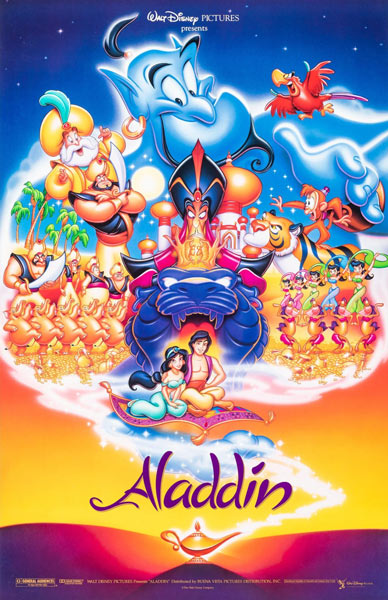Aladdin
Genre: Animated Adventure | Age: 8-9
AGE RECOMMENDATIONS New Search
Ages 4 & under -- For A Few
Ages 5 to 7 -- With Guidance
Ages 8 to 9 -- Yes
Ages 10 to 12 -- Yes
Ages 13 to 15 -- Yes
Ages 15 to 17 -- Maybe
Animated Adventure, 1992 – G. Aladdin, an orphan who lives in the streets of ancient Baghdad is recruited by the evil Jafar to go into the Cave of Miracles to recover a magical lamp from among a vast treasure. Discovering the genie inside, Aladdin keeps the lamp for himself along with a magical flying carpet. With their help he courts Jasmine, the Sultan’s daughter, and fights Jafar’s attempts to take over the kingdom and marrying Jasmine.
VIOLENCE/SCARINESS: Moderate but cartoonish violence throughout. Aladdin has several narrow, harrowing escapes from both the police and the villains.
CRIMES: Theft (U), Theft (P), Rebellion (P).
MORALS, ISSUES & VALUES: The morals of Aladdin, like most of Disney’s films, are quite complex (with a nod toward the conservative). Bad are vanity, misrepresenting one’s social status, attempting a palace coup, marrying someone much younger than one’s self, trying to gain advantage over a rightful head of state. Good are marriage, father’s power, honesty, keeping promises, sharing with the poor, helping others in need, serving one’s country, sacrificing personal feelings for the general good, and so on. On the other hand, we can make another list that points in quite a different direction, where money (forbidden in the cave of wonders and ignored by Jasmine on Prince Ali’s entry into the city), being macho (which is not condemned with the vehemence it was in Beauty and the Beast, where it was punished lethally), disrespecting women’s freedom to choose are all bad, while education and enlightenment – symbolized by the lamp – are good. There is no single story here, and this is where parents come in: we must first be aware of what is there and then carefully pick and choose what to emphasize for our children.
Aladdin doesn’t want to be the sultan; he sees this as only another form of entrapment. Jasmine doesn’t want to be the Queen, for this would force her to remain in the palace. At the end of the film, despite the happy feelings we get, they get married and are trapped forever in their designated but unwanted roles. They never achieve their wished-for freedom. Who does achieve freedom? The Genie! Is the film saying that the possession objects and materials is not the answer to freedom, power is not the answer to freedom, but mental capabilities are? This would seem a logical step, given the ideological transitions from Little Mermaid – which says little about intelligence – to Beauty and the Beast – which features a literate heroine – to Aladdin.
According to the film: Stealing is acceptable under certain conditions, such as survival. Lying about your personal accomplishments does not pay off in the long run. You are the best source of your own development; don’t use outside models. Despite desires for personal freedom, service to the community is more important than your own destiny.
SEXUALITY & GENDER ISSUES: Single parent family. Traditional gender roles with Jasmine occasionally speaking her mind, but always in need of rescue. Jasmine seems a little older and more developed than Ariel of Little Mermaid, though just as naive and trusting of the world outside her cloistered home. Her room in the cotton-candy palace resembles nothing more than a very fancy birdcage, symbolizing her feelings of confinement. Gone, however, is the “cute” Disney girl with her turned-up nose and high cheekbones. In profile, Jasmine’s nose reveals that she could indeed be from the mid-East, bearing as it does a strong resemblance to Barbra Streisand’s!
SUBSTANCES: Brief glimpses of wine bottles.
BOOK: Philip Smith, “Aladdin and Other Favorite Arabian Night Stories,” or W. Heath Robinson, “Aladdin and Other Tales from the Arabian Nights.”
COMMENTS: If Little Mermaid and Beauty and the Beast are girls’ films, then Aladdin is a boys’ film. While this film takes place in a foreign and exotic country, the issues are familiar: homelessness, of feeling trapped in your parents’ plans, of finding your true self, meeting girls, and of the disadvantages of lying. Aladdin is from a broken home, a denizen of the streets of a large city, and his survival skills are peaked from necessity. He is a ghetto kid and, as his theme song says, he’s “One Jump Ahead” of the law. Aladdin stakes his future on the lamp’s magic, not realizing that his true value is within himself and has been there all the time (echoes of The Wizard of Oz). He has dreams of great destinies, yet can’t pump up his courage even to speak to a girl. Typically adolescent.
STARRING: Voices of Scott Weinger, Robin Williams, Linda Larkin, Jonathan Freeman, Frank Welker, Gilbert Gotfried, Douglas Seale.
CONTENT REVIEW (1-5)
Nudity -- 0Sexuality -- 1
Physical Violence -- 3
Emotional Stress -- 3
Blood or Gore -- 0
Language/Profanity -- 0
Immorality -- 2
Parental Guidance -- 2
Watchability for Adults -- 3
Overall (For Kids of the Appropriate Age) -- 4
